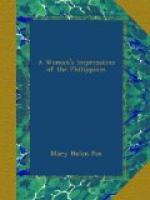At the time we landed in Manila “Mex” stood with gold at an even ratio of two pesos “Mex” for one dollar gold. I innocently allowed a bank to transfer a gold balance on a letter of credit to an account in local currency at that ratio. A few weeks later, when I wanted to change back and carry my account in gold, they wrote me courteously but firmly that I would have to buy back that account at the ratio of 2.27, and by the time that the transfer was finally effected, gold had jumped to 2.66. We had been told by a circular from the War Department, at the time our appointments were made, that we should be paid in gold. I drew just one cheque in U.S. currency after reaching the Islands. My second cheque was drawn in local currency at a ratio of 2.27, but, by the time it had reached me at Capiz, gold had gone to 2.46. We had to endure the evils of a fluctuating currency for over two years. On all money sent to the States we lost heavily. So far as our daily expenses were concerned we in the provinces had very little inconvenience to suffer on account of “Mex”; but in Manila all merchants fixed their prices in gold and took occasion to put them up mercilessly. I remember trying to buy some Japanese matting which could have been bought for twenty-five cents a yard in the States, but which was priced at seventy-five cents in Manila. The merchant wanted me to pay him in “Mex” at a ratio of 2.66, or at the rate of two pesos a yard for matting which he bought in Japan at probably less than twenty sen a yard.
There was a tremendous protest against the fluctuating currency and the extortion which grew out of it, and we were all relieved when we learned that Congress had adopted the so-called “Conant” system of currency for the Islands. Mr. Conant was the expert who investigated conditions for the Government and devised the system.
The Conant system followed the old Spanish values for coins, the new coins being pesos, medio-pesos, pesetas, media-pesetas, nickels, and copper cents. There was also a copped half-cent, but neither Congress nor Mr. Conant read the Filipino aright. In two years we had taught him to sniff at any value less than a cent. The new system is held at a ratio of two to one by the Government’s redeeming it in the Philippine treasury at a ratio of two pesos Conant to one dollar U.S. The importation of “Mex” is no longer permitted, and we rejoice in a stable currency once more.
We provincials followed the newspaper talk about the new system with no small interest. When our treasurer informed us that he had received a consignment of the new currency, and that our next salary cheques would be paid in “Conant,” we were delighted. My cheque, by some accident, got in ahead of those of the other employees, and was the first presented for payment.
The beautifully made, bright new silver coins had an engaging appearance after the tarnished mongrel coins to which we were accustomed. When the Treasurer had counted out all my hard-earned money except ten pesos, he produced two bags of pennies, and announced that I should have to take that sum in small coin in order to get the pennies into circulation. They were of beautiful workmanship, yellow as gold and heavy as lead. I called in the aid of a small boy to help me lug home my three bags of coin.




